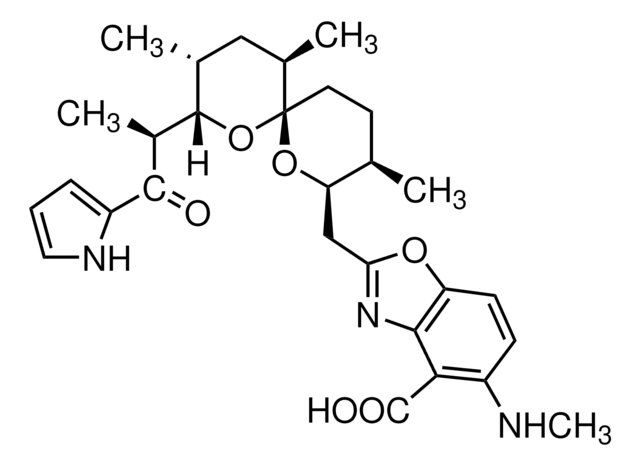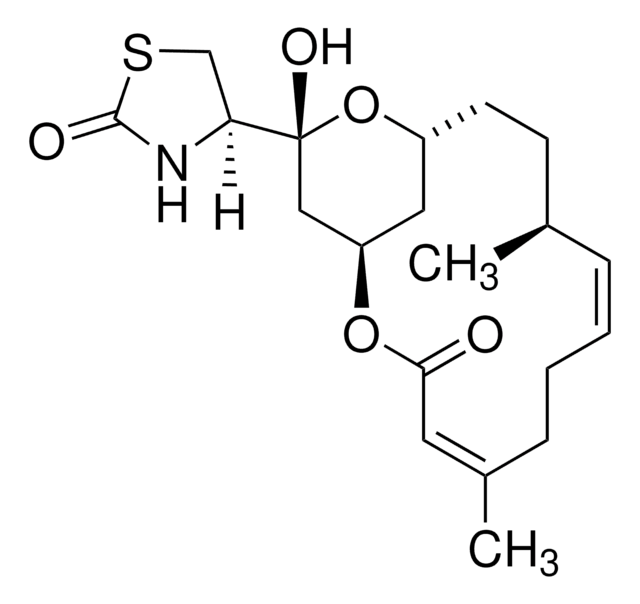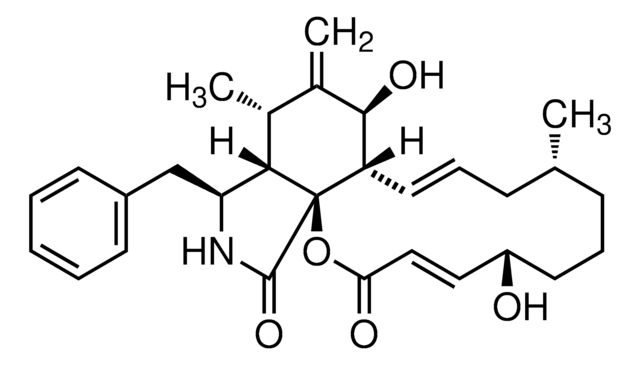おすすめの製品
アッセイ
≥98% (HPLC)
形状
powder
色
white to beige
溶解性
DMSO: 2 mg/mL, clear
保管温度
2-8°C
SMILES記法
O=C(C(C(C)C)=C(C)N1C)N1C2=CC=C(S(NCCOC3=CC=CC=C3)(=O)=O)C=C2
生物化学的/生理学的作用
BC-LI-0186 is a selective blocker of Leucyl-tRNA synthetase (LRS; LeuRS) and Ras-related GTP-binding protein D (RagD) interaction (IC50 = 46.11 nM) by competing against RagD for LRS VC domain binding (KD = 42.1 nM) without affecting LRS-Vps34, LRS-EPRS, RagB-RagD association, mTORC1 complex formation or the activities of 12 kinases. BC-LI-0186 inhibits Leu-dependent LRS lysosomal membrane localization (10 μM), RagD GTPase and mTORC1 activation (IC50 = 81.4 nM against Leu-induced S6K phosphorylation), but not ARF1 activation, AKT S473 phosphorylation, Glu- or Arg-dependent S6K phosphorylation, nor the cytosolic and mitochondrial LRS catalytic activities. BC-LI-0186 effectively suppresses the growth of rapamycin-resistant MCT116 MM cancer cells with mTOR-S2035I mutation both in cultures (GI50 = 42.03) and in mice in vivo (by 40% in 2 wks; 20 mg/kg/day i.p.).
保管分類コード
11 - Combustible Solids
WGK
WGK 3
引火点(°F)
Not applicable
引火点(℃)
Not applicable
適用法令
試験研究用途を考慮した関連法令を主に挙げております。化学物質以外については、一部の情報のみ提供しています。 製品を安全かつ合法的に使用することは、使用者の義務です。最新情報により修正される場合があります。WEBの反映には時間を要することがあるため、適宜SDSをご参照ください。
Jan Code
SML2226-BULK:
SML2226-VAR:
SML2226-5MG:
SML2226-25MG:
試験成績書(COA)
製品のロット番号・バッチ番号を入力して、試験成績書(COA) を検索できます。ロット番号・バッチ番号は、製品ラベルに「Lot」または「Batch」に続いて記載されています。
Hyosun Choi et al.
Biochemical and biophysical research communications, 493(2), 1129-1135 (2017-09-09)
Leucyl-tRNA synthetase (LRS) plays major roles in providing leucine-tRNA and activating mechanistic target of rapamycin complex 1 (mTORC1) through intracellular leucine sensing. mTORC1 activated by amino acids affects the influence on physiology functions including cell proliferation, protein synthesis and autophagy
Jong Hyun Kim et al.
Nature communications, 8(1), 732-732 (2017-10-01)
Leucyl-tRNA synthetase (LRS) is known to function as leucine sensor in the mammalian target of rapamycin complex 1 (mTORC1) pathway. However, the pathophysiological significance of its activity is not well understood. Here, we demonstrate that the leucine sensor function for mTORC1
ライフサイエンス、有機合成、材料科学、クロマトグラフィー、分析など、あらゆる分野の研究に経験のあるメンバーがおります。.
製品に関するお問い合わせはこちら(テクニカルサービス)







